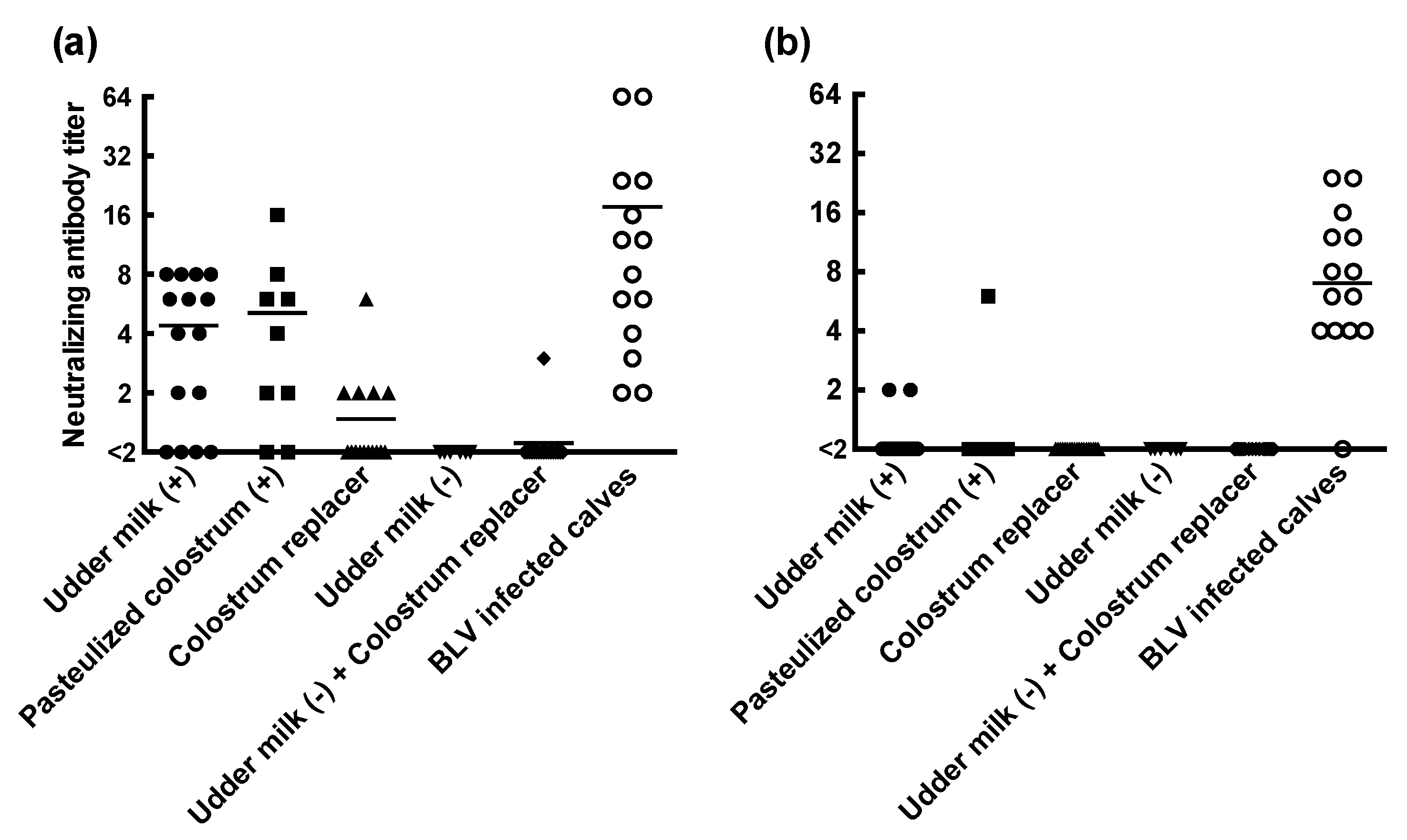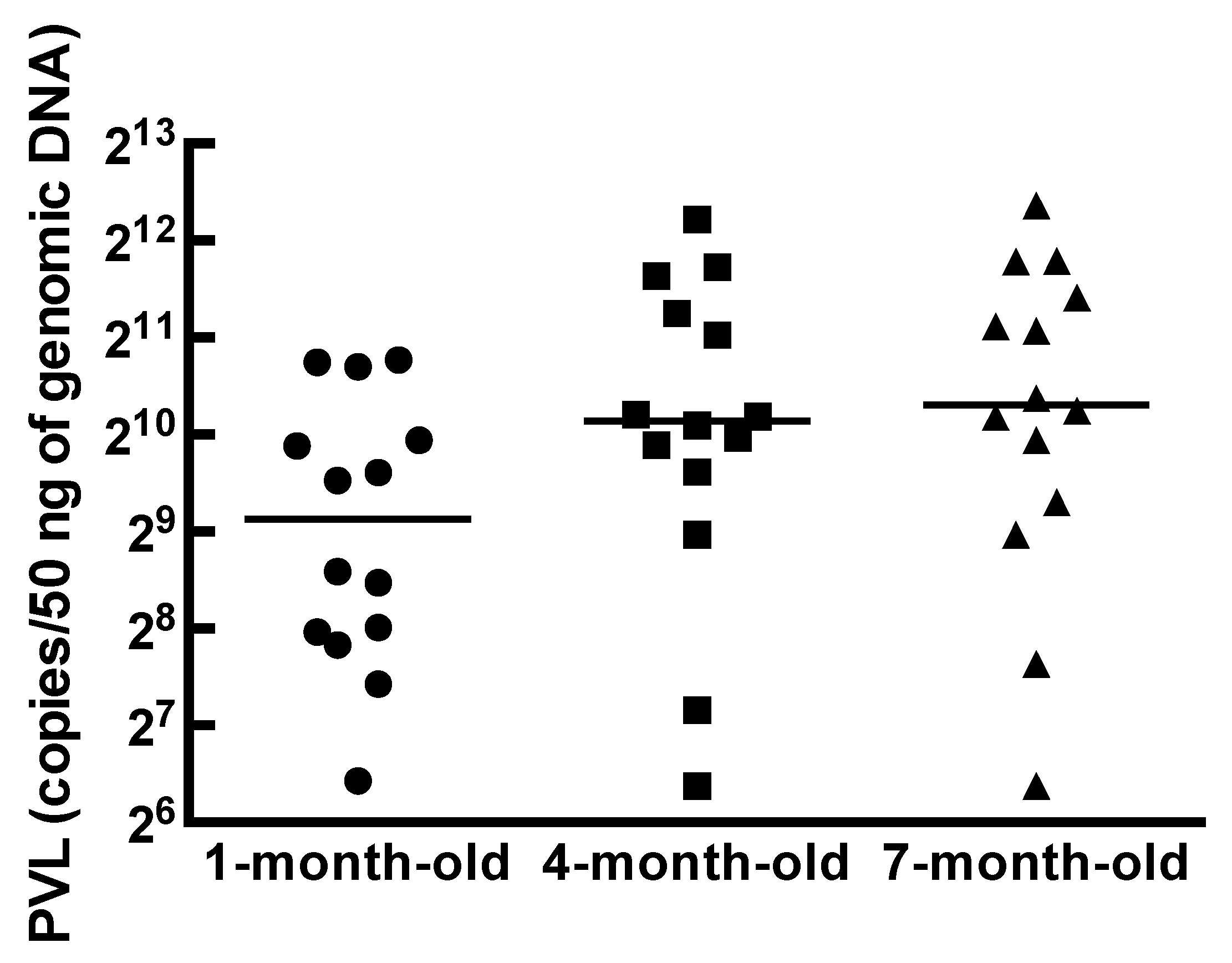Avoidance of Natural Suckling from Dams with Bovine Leukemia Virus Is a Low Priority Countermeasure against Postnatal Transmission
Abstract
1. Introduction
2. Materials and Methods
2.1. Animals and Samples
2.2. ELISA and Real-Time PCR
2.3. PVL Classification of Cattle with BLV
2.4. Detection and Quantification of Proviral DNA in Colostrum
2.5. Neutralizing Antibody Titers in Calves
2.6. Statistical Analysis
3. Results
4. Discussion
5. Conclusions
Author Contributions
Funding
Institutional Review Board Statement
Informed Consent Statement
Data Availability Statement
Acknowledgments
Conflicts of Interest
References
- Schwartz, I.; Lévy, D. Pathobiology of Bovine Leukemia Virus. Vet. Res. 1994, 25, 521–536. [Google Scholar]
- Tsutsui, T.; Kobayashi, S.; Hayama, Y.; Yamamoto, T. Fraction of Bovine Leukemia Virus-Infected Dairy Cattle Developing Enzootic Bovine Leukosis. Prev. Vet. Med. 2016, 124, 96–101. [Google Scholar] [CrossRef]
- Murakami, K.; Kobayashi, S.; Konishi, M.; Kameyama, K.; Tsutsui, T. Nationwide Survey of Bovine Leukemia Virus Infection among Dairy and Beef Breeding Cattle in Japan from 2009–2011. J. Vet. Med. Sci. 2013, 75, 1123–1126. [Google Scholar] [CrossRef]
- Bauermann, F.V.; Ridpath, J.F.; Dargatz, D.A. Bovine Leukemia Virus Seroprevalence among Cattle Presented for Slaughter in the United States. J. Vet. Diagn. Investig. 2017, 29, 704–706. [Google Scholar] [CrossRef]
- Sajiki, Y.; Konnai, S.; Nishimori, A.; Okagawa, T.; Maekawa, N.; Goto, S.; Nagano, M.; Kohara, J.; Kitano, N.; Takahashi, T.; et al. Intrauterine Infection with Bovine Leukemia Virus in Pregnant Dam with High Viral Load. J. Vet. Med. Sci. 2017, 79, 2036–2039. [Google Scholar] [CrossRef][Green Version]
- Romero, C.H.; Cruz, G.B.; Rowe, C.A. Transmission of Bovine Leukaemia Virus in Milk. Trop. Anim. Health Prod. 1983, 15, 215–218. [Google Scholar] [CrossRef]
- Mekata, H.; Sekiguchi, S.; Konnai, S.; Kirino, Y.; Honkawa, K.; Nonaka, N.; Horii, Y.; Norimine, J. Evaluation of the Natural Perinatal Transmission of Bovine Leukaemia Virus. Vet. Rec. 2015, 176, 254. [Google Scholar] [CrossRef]
- Konishi, M.; Ishizaki, H.; Kameyama, K.; Murakami, K.; Yamamoto, T. The Effectiveness of Colostral Antibodies for Preventing Bovine Leukemia Virus (BLV) Infection in Vitro. BMC Vet. Res. 2018, 14, 419. [Google Scholar] [CrossRef]
- Barrington, G.M.; Parish, S.M. Bovine Neonatal Immunology. Vet. Clin. N. Am. Food Anim. Pract. 2001, 17, 463–476. [Google Scholar] [CrossRef]
- Meas, S.; Usui, T.; Ohashi, K.; Sugimoto, C.; Onuma, M. Vertical Transmission of Bovine Leukemia Virus and Bovine Immunodeficiency Virus in Dairy Cattle Herds. Vet. Microbiol. 2002, 84, 275–282. [Google Scholar] [CrossRef]
- Yamaguchi, K.; Watanabe, T. Human T Lymphotropic Virus Type-I and Adult T-Cell Leukemia in Japan. Int. J. Hematol. 2002, 76, 240–245. [Google Scholar] [CrossRef] [PubMed]
- Aida, Y.; Murakami, H.; Takahashi, M.; Takeshima, S.N. Mechanisms of Pathogenesis Induced by Bovine Leukemia Virus as a Model for Human T-Cell Leukemia Virus. Front. Microbiol. 2013, 4, 328. [Google Scholar] [CrossRef]
- Hino, S.; Katamine, S.; Kawase, K.; Miyamoto, T.; Doi, H.; Tsuji, Y.; Yamabe, T. Intervention of Maternal Transmission of HTLV-1 in Nagasaki, Japan. Leukemia 1994, 8, S68–S70. [Google Scholar]
- Oki, T.; Yoshinaga, M.; Otsuka, H.; Miyata, K.; Sonoda, S.; Nagata, Y. A Sero-Epidemiological Study on Mother-to-Child Transmission of HTLV-I in Southern Kyushu, Japan. Asia-Ocean. J. Obstet. Gynaecol. 1992, 18, 371–377. [Google Scholar] [CrossRef]
- Hino, S. Establishment of the Milk-Borne Transmission as a Key Factor for the Peculiar Endemicity of Human T-Lymphotropic Virus Type 1 (HTLV-1): The ATL Prevention Program Nagasaki. Proc. Jpn. Acad. Ser. B 2011, 87, 152–166. [Google Scholar] [CrossRef]
- Nagy, D.W.; Tyler, J.W.; Kleiboeker, S.B. Decreased Periparturient Transmission of Bovine Leukosis Virus in Colostrum-Fed Calves. J. Vet. Intern. Med. 2007, 21, 1104–1107. [Google Scholar] [CrossRef]
- Ferrer, J.F.; Piper, C.E. Role of Colostrum and Milk in the Natural Transmission of the Bovine Leukemia Virus. Cancer Res. 1981, 41, 4906–4909. [Google Scholar] [PubMed]
- Chase, C.C.L.; Hurley, D.J.; Reber, A.J. Neonatal Immune Development in the Calf and Its Impact on Vaccine Response. Vet. Clin. N. Am. Food Anim. Pract. 2008, 24, 87–104. [Google Scholar] [CrossRef]
- Windeyer, M.C.; Leslie, K.E.; Godden, S.M.; Hodgins, D.C.; Lissemore, K.D.; LeBlanc, S.J. Factors Associated with Morbidity, Mortality, and Growth of Dairy Heifer Calves up to 3 Months of Age. Prev. Vet. Med. 2014, 113, 231–240. [Google Scholar] [CrossRef]
- Baumgartener, L.; Olson, C.; Onuma, M. Effect of Pasteurization and Heat Treatment on Bovine Leukemia Virus. J. Am. Vet. Med. Assoc. 1976, 169, 1189–1191. [Google Scholar]
- Rubino, M.J.; Donham, K.J. Inactivation of Bovine Leukemia Virus-Infected Lymphocytes in Milk. Am. J. Vet. Res. 1984, 45, 1553–1556. [Google Scholar] [PubMed]
- Takeshima, S.N.; Sasaki, S.; Meripet, P.; Sugimoto, Y.; Aida, Y. Single Nucleotide Polymorphisms in the Bovine MHC Region of Japanese Black Cattle Are Associated with Bovine Leukemia Virus Proviral Load. Retrovirology 2017, 14, 24. [Google Scholar] [CrossRef] [PubMed]
- Mekata, H.; Minamino, T.; Mikurino, Y.; Yamamoto, M.; Yoshida, A.; Nonaka, N.; Horii, Y. Evaluation of the Natural Vertical Transmission of Theileria orientalis. Vet. Parasitol. 2018, 263, 1–4. [Google Scholar] [CrossRef]
- Mekata, H.; Yamamoto, M.; Hayashi, T.; Kirino, Y.; Sekiguchi, S.; Konnai, S.; Horii, Y.; Norimine, J. Cattle with a Low Bovine Leukemia Virus Proviral Load Are Rarely an Infectious Source. Jpn. J. Vet. Res. 2018, 66, 157–163. [Google Scholar] [CrossRef]
- Gillet, N.A.; Gutiérrez, G.; Rodríguez, S.M.; de Brogniez, A.; Renotte, N.; Alvarez, I.; Trono, K.; Willems, L. Massive Depletion of Bovine Leukemia Virus Proviral Clones Located in Genomic Transcriptionally Active Sites during Primary Infection. PLoS Pathog. 2013, 9, e1003687. [Google Scholar] [CrossRef]
- Li, H.C.; Biggar, R.J.; Miley, W.J.; Maloney, E.M.; Cranston, B.; Hanchard, B.; Hisada, M. Provirus Load in Breast Milk and Risk of Mother-to-Child Transmission of Human T Lymphotropic Virus Type I. J. Infect. Dis. 2004, 190, 1275–1278. [Google Scholar] [CrossRef]
- Fukuyama, S.; Kodama, K.; Hirahara, T.; Nakajima, N.; Takamura, K.; Sasaki, O.; Imanishi, J. Protection against Bovine Leukemia Virus Infection by Use of Inactivated Vaccines in Cattle. J. Vet. Med. Sci. 1993, 55, 99–106. [Google Scholar] [CrossRef]
- Kono, Y.; Arai, K.; Sentsui, H.; Matsukawa, S.; Itohara, S. Protection against Bovine Leukemia Virus Infection in Sheep by Active and Passive Immunization. Jpn. J. Vet. Sci. 1986, 48, 117–125. [Google Scholar] [CrossRef] [PubMed]
- Ferrer, J.; Kenyon, S.; Gupta, P. Milk of Dairy Cows Frequently Contains a Leukemogenic Virus. Science 1981, 213, 1014–1016. [Google Scholar] [CrossRef]
- Takezaki, T.; Tajima, K.; Ito, M.; Ito, S.; Kinoshita, K.; Tachibana, K.; Matsushita, Y. Short-Term Breast-Feeding May Reduce the Risk of Vertical Transmission of HTLV-I. The Tsushima ATL Study Group. Leukemia 1997, 11, 60–62. [Google Scholar]


| BLV Status in Sampling Dams | |||
|---|---|---|---|
| High PVL a | Middle PVL a | Low PVL a | |
| PCR positivity | 92.3% (12/13) | 41.6% (5/12) | 0% (0/15) |
| Range of PVL (copies/mL of colostrum) | 750–8500 | 500–2500 | - |
| Median (average) value of PVL (copies/mL of colostrum) | 2250 (2999) | 1500 (1500) | - |
| Sample Group | Types of Feeding Milk | BLV Status in Dams of Sampled Calves | |||
|---|---|---|---|---|---|
| High PVL a | Middle PVL a | Low PVL a | BLV (-) | ||
| 1 | Natural suckling | 60.0% (6/10) | 37.5% (3/8) | 0% (0/10) | - |
| Artificial rearing b | 0% (0/3) | 50.0% (2/4) | 0% (0/5) | - | |
| 2 | Natural suckling | - | 20.0% (1/5) | 0% (0/11) | 0% (0/24) |
| Artificial rearing | 58.3% (7/12) | 50.0% (6/12) | 0% (0/9) | 0% (0/8) | |
| Total | Natural suckling | 60.0% (6/10) | 30.7% (4/13) | 0% (0/21) | 0% (0/24) |
| Artificial rearing | 46.6% (7/15) | 50.0% (8/16) | 0% (0/14) | 0% (0/8) | |
Publisher’s Note: MDPI stays neutral with regard to jurisdictional claims in published maps and institutional affiliations. |
© 2021 by the authors. Licensee MDPI, Basel, Switzerland. This article is an open access article distributed under the terms and conditions of the Creative Commons Attribution (CC BY) license (https://creativecommons.org/licenses/by/4.0/).
Share and Cite
Mekata, H.; Kusuda, E.; Mori, C. Avoidance of Natural Suckling from Dams with Bovine Leukemia Virus Is a Low Priority Countermeasure against Postnatal Transmission. Vet. Sci. 2021, 8, 255. https://doi.org/10.3390/vetsci8110255
Mekata H, Kusuda E, Mori C. Avoidance of Natural Suckling from Dams with Bovine Leukemia Virus Is a Low Priority Countermeasure against Postnatal Transmission. Veterinary Sciences. 2021; 8(11):255. https://doi.org/10.3390/vetsci8110255
Chicago/Turabian StyleMekata, Hirohisa, Eriko Kusuda, and Chiho Mori. 2021. "Avoidance of Natural Suckling from Dams with Bovine Leukemia Virus Is a Low Priority Countermeasure against Postnatal Transmission" Veterinary Sciences 8, no. 11: 255. https://doi.org/10.3390/vetsci8110255
APA StyleMekata, H., Kusuda, E., & Mori, C. (2021). Avoidance of Natural Suckling from Dams with Bovine Leukemia Virus Is a Low Priority Countermeasure against Postnatal Transmission. Veterinary Sciences, 8(11), 255. https://doi.org/10.3390/vetsci8110255






